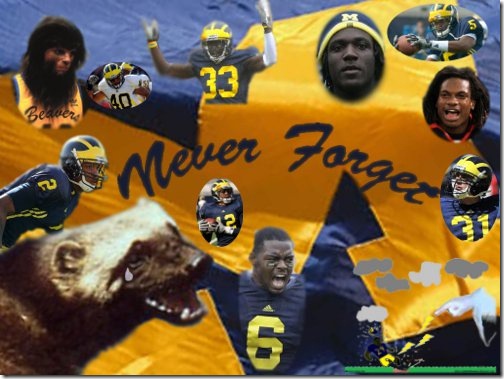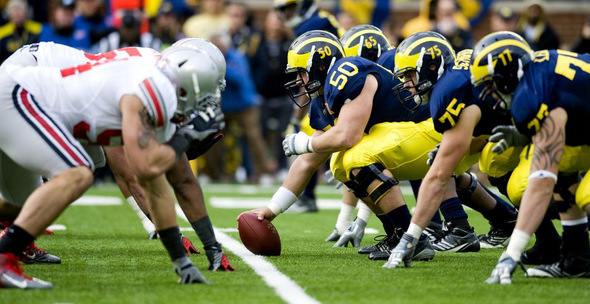When Michigan gets commitments from recruits, I always like to see what the reaction is at the
Michigan board. There's usual jubilation and what not. Equally interesting is seeing the reaction of
rival schools' boards. It's funny because there's always a put down or a rationalization that goes with these commitments.
This weekend, Michigan got eight 4-star commitments, all of whom are in the
Top 200 on Rivals.
That's the context. That's what inspired this post. Both the onslaught of commitments to Michigan this weekend as well as the reaction of the fans of other schools.
 |
| Where is your new bicycle? |
Recruiting is like Christmas. No wait, it's like a birthday. When a player commits, it's like getting that big shiny 3 speed Schwinn Sting Ray. You're really happy about it. You want to show it off and ride around the block for all your friends to see. Your friends are jealous. They'll mask their jealousy by saying "I didn't want that bike anyway" or "I will still beat you in a race."
I think I illustrated the reactions of Buckeye and Spartan fans pretty well.
Buckeye fans are pretty arrogant (yeah, I know it's funny coming from a Michigan alum/fan) right now. They have raised their already high expectations after
hiring Urban Meyer. Part of what contributed to that was the way Meyer ended his
2012 class. They think they should get nothing but the best both in recruiting and on the field. They expect Meyer to
dominate Brady Hoke on the recruiting trail. They also are the first ones to point out that a lot of these commits
did not have OSU offers.
Let's try and grapple with the situation here.
First off, it's early in the recruiting cycle. We're almost two months away from teams' Spring Games. Not all the offers have gone out yet. Coaches are still in the process of evaluating players and sending out offers. Both Michigan and Ohio State have cast out nets in the form of offers.
Michigan's net has been a little bigger (86 vs 65) than
Ohio State's net. Those nets have covered a lot of the same players, but also a lot of players who only hold offers from one of the schools.
The important thing is that these two schools aren't handing out prospects to any regular player. They're giving offers to the best players in the country. I guarantee you right now that if both programs fill out their classes with the players that they have already offered, both fanbases will be more than satisfied with their coach's job. You know, so long as their coach did better than the other coach.
The fact of the matter is that Michigan is closer to filling their class with the top guys that they offered at the moment than Ohio State. Their coach is doing better. However, Ohio State fans think their coach can do better. When you factor that in with the relatively low number of head to head battles, this weekend changed nothing in their heads.
 |
| Buckeye fans think Urban has a strong reputation on the recruiting trail |
Buckeyes fans are both quick and right to say that Meyer is winning head to head battles for their commits. That's if your only qualifying issue is an offer from both schools. Michigan had
offered all the guys to commit to Ohio State, but all those guys were considered heavy Ohio State leans to begin with. With a lesser depth of talent in Michigan, the Wolverines will have to look throughout the Midwest to find players, including Ohio. Ohio has the most talent in the Midwest, so there's enough available beyond what the Buckeyes need or want. Many of the Ohio guys that end up at Michigan grew up as Buckeye fans.
The fact of the matter is that when you're recruiting out of state, you're likely to face an uphill battle. You're likely going to have to turn someone's fandom. Of the three Ohio kids that have committed to Michigan, Taco Charlton and Jake Butt were both Ohio State fans. They were turned. Neither of them had offers from Ohio State. Both are in the top 200 on Rivals. While you can say that Ohio State wasn't interested or did not recruit them, you cannot deny the fact that Michigan got two good players.
Then you have Michigan State, Sparty in my part of the world.
They always have a chip on their shoulder. Who can blame them? They don't bring in the prospects that Michigan and Ohio State does. The school isn't as highly regarded as Michigan. The football program isn't as prestigious. The thing they have most going for them at the moment is the fact that they have had great success recently against Michigan.
They won't shut up about it, not that they should. You should hold recent success over your rival's head. However, they don't recognize the importance of having good recruiting classes. They say Michigan has had good classes yet Michigan State has
still beaten them. Well, here's the thing; Michigan had an abnormally high rate of attrition for those classes. You had guys transferring and you had guys getting into trouble with the law.
 |
| Michigan players who didn't make it |
Hoke has changed things up. He's not only recruiting kids who are highly regarded, but also kids of high character. These kids will stay in the program and there will be less attrition. This coaching staff is better than the previous staff. They teach their players football. They teach fundamentals. You'll see this on the field. I'm not saying that this guarantees Michigan victories over Michigan State, but it definitely makes a difference.
To go back to the back metaphor, if you have a better bike and you're equally skilled riders, you're more likely to win. It's as simple as that.
Conversely, because rivalries go both ways, Michigan State got an in-state 4-star linebacker that Michigan hadn't offered. Much of this might have to do with Michigan taking
four players at the position in this past year's class, and therefore, have earned the right to be selective (he also doesn't fit the LB position of need, SAM, for Michigan, but we'll just keep it simple). There was also commentary that he
wasn't good enough to earn an offer or that he was a MSU lean. Of course, Spartan fans had a
milliad of excuses.
Without regards to the facts, both fanbases come off as petty. Michigan fans put their own spin on it, saying he wasn't good enough or he wasn't worth the effort. Michigan State fans should be happy for landing a good player. The reality is a combination of these two stories, but the two sides are only going propagate whatever is favorable to them.
***
These arguments that fanbases have resulting from commitments is just stupid. It's also what makes college football great. It's a year round cycle of celebration, hatred, schadenfreude, and bickering. Your team might be your colors, but your rivals bring out your worst colors. That's the point that I'm trying to get across.
No fanbase is innocent.





